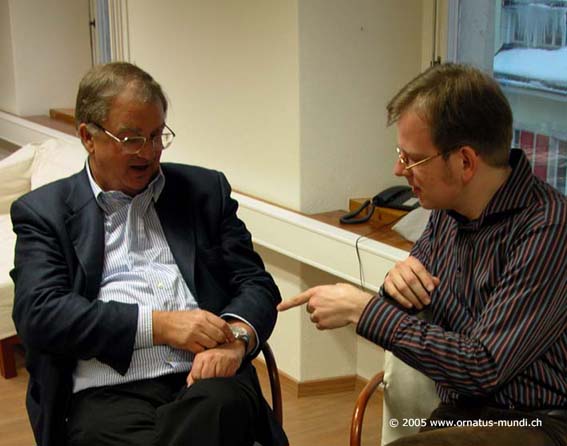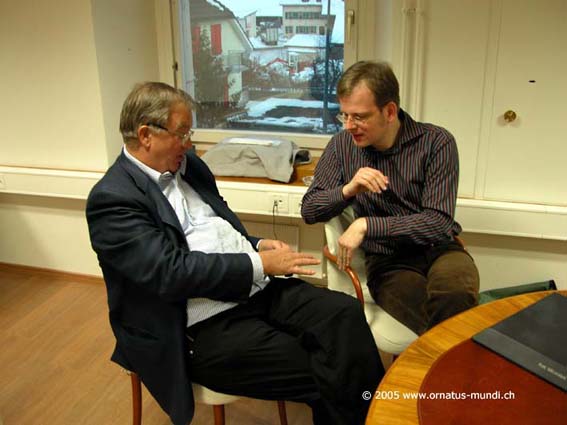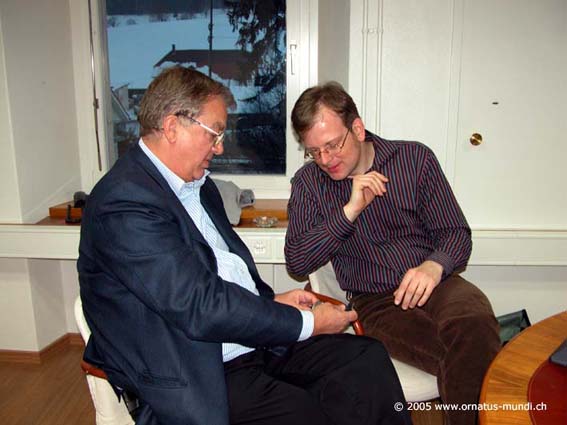Like Phoenix from the ashes - the astonishing rebirth of Minerva SA, Villeret
by Magnus Bosse, May 2005
Part
4
4.
Interview with Beppe Menaldo, CEO of Minerva S.A.

Certainly, the (recent) history of Minerva S.A. is one of the most disputed ones in the watch industry. As already laid out in the introductory chapter, the change of ownership in 2000, along with the subsequent turnaround of the philosophy of the company, caused much stirr. Mr. Beppe Menaldo, CEO of Minerva ever since, gives highly interesting insights in the recent years and Minerva's current state. The interview was conducted at the Minerva Manufacture in Villeret, Switzerland on 7 February 2005.
-------------------------------------------------------------
Magnus
Bosse (MB): : Mr Menaldo, first of all I want to thank
you for taking your precious time to make my visit here so fruitful!
Beppe Menaldo (BM): I wish to make some initial comments
about how Minerva was treated by the internet watch community after
Mr. Gnutti bought the company. Much things have been said about me,
Beppe Menaldo, or Mr. Gnutti, which were simply not true. We had basically
two possibilities to react: the one was, to actively engage ourselves,
and the other was to leave it like it was. At the end, I decided not
to act and to ignore all the [**peep!**] which was written
at that time.
I want the people to know that we came to Minerva SA to create something
beautiful, something authentic. And this is what we want to communicate
with this interview, and I’m happy top learn that you are actually
intending to write an authentic article, not a horror-story, but also
not a marketing pamphlet, about us.
MB: Thanks a lot. I prepared a few question that I like to pose.
BM: Well, I hope I'll have an answer to all of them…
MB:
Mr. Menaldo, could you describe the moment when the Frey family decided
to sell Minerva? How was the contact to you and Mr. Gnutti established?
What made him interested in Minerva?
BM: It came totally unintended and completely by chance!
I had contact to Mr. Frey since quite a time. One day, he proposed a
collaboration with the aim to relaunch the brand, but he never became
very specifc with the project. It was about August or September 2000,
when we had a telephone call, I was in Milano at that time. I had the
impression that he had some underground reasons not to go on with the
relaunch project, and I asked the decisive question totally out of the
blue: “Do you want to sell Minerva?” – Mr. Frey answered
quite frankly: “Why not?”! So since that moment I was in
a deep shit: I simply didn’t know what to say because I really
did not expect that! A few seconds later I had to take up the ball and
asked for his price. He gave me a number, and on that basis I spoke
with Minerva’s retailer in Brescia about the situation, and this
man was a good friend of Mr. Gnutti. At that time I didn’t know
Mr. Gnutti at all. As you can see, neither Mr. Gnutti nor me are in
the business of buying and selling companies. I never did it in the
past and I don’t know if I will ever do this again (laughs!).
I worked in the watchmaking business for 38 years. I was in charge for
Blancpain in Italy, and before that for Breguet...
MB: … so you know Mr. Jean-Claude Biver…
BM: … yes, I know him very well: in a good way
and in a bad way! A very special person, that’s the minimum to
say about him!
MB: What was your impression when you came to Minerva? Did you want
to relaunch Minerva as a Haute Horlogerie manufacture from
the beginning? Or did you chose this way later after you arrived?
BM: Before we came to Minerva, we heared many beautiful
and encuraging things about this company. Last but not least, this watch
brand was cherished by collectors. But the real situation was a nothing
less than a catastrophy: Already at that time the bright shine was not
entirely immaculate. There was literally no capacity of production at
all! For example, the platines of the Calibre 48 they assembled then
were actually produced some 50 years ago! But the image Minerva had
in the watch aficionado’s community still was that of an true
manufacture!
During the course of my life, I came in intensive contact to some of
the finest watch companies on the planet. I learned how to take care
of brands of such a class. And I can guarantee you that I cannot take
care of low range product. Therefore, our intention from the beginning
was to produce authentical Minerva movements of highest quality. This
was actually my personal intention, and not the idea of our financier,
Mr. Gnutti.
To address that, we had to start nearly from scratch: First, we had
to establish not only the technical, but also the human basis for a
successfull Haute Horlogerie manufacture, that means to attract highly
skilled watchmakers to work with us. By chance, and this was also only
possible due to my own personal history, we could meet extremely competent
people, amongst them Mr. Cabiddu, now head of the technical departement
of Minerva. With his help, we were able to develop a technical and aesthetical
concept of the new Minerva watches, and this includes the construction
of completely new calibres of highest quality and with perfect finish.
Mr. Calibre (Menaldo laughs!), sorry!, of course Mr. Cabiddu,
is one of the few very highly skilled contemporary watchmakers in the
world. For example, he worked together with Gerald Genta (the man!),
and constructed and created Grande Sonnerie Minute Repeaters from scratch.
I’m really happy and delighted to start into this adventure together
with him!
MB: So, the first result was, as it was widely precieved, the
huge increase of the prices. Could you explain a little bit what the
new watches have that the older were lacking?
BM: We have to ask ourselves: What does the term Haute
Horlogerie mean? And we have to agree on the tenor of the term
Manufacture. If we agree that these do mean to buy movements,
encase them and to sell them, then almost all Swiss watchmaking companies
are manufactures! But if we choose a very strict and narrow
definition, then only very, very few companies are left. Minerva today
does not use a single movement supplied from outside! Additionally,
all other components are truely Swiss Made and are of exquisite quality.
Take for example our new sapphire crystals: it is as expensive to manufacture
as many complete movements of our competitors (or even 10 times the
price of an ETA 2824!).
If you visit the well-known watch ateliers specialised in constructing
movements, you will spot calibres developed for many renowned brands
– but you will never find a Minerva movement there! So, if one
wants to compare prices, then one has to compare apples and apples,
and not apples and oranges. This important to consider!
Demetrio Cabiddu (joins the discussion): Furthermore,
we are producing only very small quantities, so the price per watch
has to be much higher. For these new pieces, we took an inspiration
from the movements produced by Minerva in the 1920s, at a time Minerva
was owned by the Robert family (remark: the Robert family owned Minerva
until they sold it to André Frey in 1940). We designed and industrialised
these four movements (remark: Calibres 62-00, 13-21, 16-15 and 16-29)
completely new from scratch, so that in fact, although the construction
looks similar to older ones, there is no interchangeability of the parts.
They are our genuine in-house movements and are characterised by several
Minerva innovations (remark: see article chapter 2). Even the screws
are different! In consequence, these movements are not something we
simply took from the past and updated it a bit. And we of course have
other calibres under development.
MB: Please explain to me the concept of the new Minerva watches! For
some brands it is the design, for others a certain technical characteristic
like the 3/4 plate. How would you describe the “new” Minerva?
BM: Beautiful question! You have already seen the finished
watches. We will not invent the wheel for a second time.
Minerva watches will always be classical watches. We would like establish
a culture in a way that when people are purchasing a Minerva watch,
they will of course be attracted by the aesthetics, but they will also
cherish the movement as well as the vivid heart of a typical Minerva
watch. We are well aware that this is quite difficult to achieve, but
this is our dream, our imagination, our driving force. That is the reason
why we developed the secret, romantical system to open the case-back
(demonstrates it with his own Minerva 16-29): If you are in the mood,
you can have a look at the movement, but if you don’t want so,
you can keep it closed and secret.
According to my estimation, this is of course not a very innovative
or exciting strategy. We simply try to be coherent with what we are.
It’s a difference to purchase any given companies which use the
same movements, or to start entirely from scratch and try to do as much
as possible on your own. The decisive factor is authenticity!
MB: So Minerva will not be the pacemaker for novel technologies?
BM: We are faithfull to the traditional, real watchmaking
arts. But this does not exclude innovation. We are aiming at the true
connaisseur of fine watchmaking art who appreciates a company's identity.
We do not want to copy what already existed in the past. Sure, we want
to add more complications to our collection, but we do not aim for ‘me-too’
movements. We always want to add new ideas to a complication.
Just to give you an example, we developed our own balance wheel and
springs. This of course to gain independence from the large conglomerates.
Monopolies are like dictatorships to me: they can decide upon life or
death of a watch company.
MB:
I already heard that you are going to introduce a new automatic movement.
Could you give us any hints?
BM: Yes, we are going further in that direction, but
we are not happy with what we created so far. We have to work harder
on this movement.

MB:
I nearly nowhere can see Minerva watches in the shops. What are your
plans to distribute your products?
BM: Honestly, our distribution network basically does
not exist. First, we wanted to demonstrate that we are able to fullfill
our claims to produce movements of the highest finesse on the market.
But I personally never was involved in the fabrication. So we had to
prove ourselves that we can do this. And we did! And then we decided
to develop not only a single movement, but to create a collection of
four. But only now we can go and try to convince dealers and clients.
That’s the reason why there was this silence about Minerva for
this apparently long time. But if you look closely, the few years that
passed until now are actually a short time for the immense work and
challenges we mastered. People who know about the difficulties associated
with true watchmaking art can appreciate it: the creation of four different
movements in this short time like we did it – that’s quite
an achievement. Additionally, we nearly finished the work on the Tourbillon
Mysterièuse, an unique Tourbillon watch with mystical, excentric
time display.
To summarise, we faced two challenges: first, to create and to produce
exceptional watches, and second, to communicate this achievements, to
market the watches so to speak. The first one we accomplished, the second
one we will! This last aspect is immensely important, just think about
admirable watch brands, which desperately failed to communicate the
excellency of their watches and consequently could not sell.
MB: How many watches do you produce each year?
BM: We produce between 600 and 700 pieces/year. Please
keep in mind that amongst this there is not a single one that is not
a 100% Minerva! We are working with the ideal, that first there is an
idea, then a concept and a prototype, and finally the small-scale production
of watches in finest execution. All of these steps are entirely performed
under this very roof. To my knowledge there is not a single
brand which tries to ensure that all these steps are carried out within
their own walls. Except Minerva, or course, and perhaps Jaeger-LeCoultre
or Glashütte Original. Even not Patek Philippe – think of
their Chronograph movement!
MB: Its amazing that the people in your manufacture are so young!
BM: Well, we like the young people. Additionally, it
is absolutely not easy to find skilled people for these challenges here
in Villeret. People who know about Haute Horlogerie and its history.
Young people, however, are extremely eager to learn, and it is a great
joy to perpetuate the knowledge of finest watchmaking to them.
MB: Mr. Menaldo, do you have any message for the watch conaisseurs
on the internet fora?
BM: There is one aspect that is close to my heart:
I would like the term “truth” to be more respected in the
watchmaking business. And I would like that – despite the respect
I have for marketing – the product, the work of the fantastic
people, the watches, would enjoy more attention. There are always a
lot of ‘”small Menaldos” and “big Bivers”
around who will do a lot of high-class and luxury events et cetera,
but it is people like Demetrio Cabiddu and others skilled watchmakers,
who are the people who really work hard for the advancement of watchmaking
art.
The uniformisation of the watchmaking scene, which is to a high degree
a result of the mergers and acquisitions we wittnessed the recent years,
brings about the danger that we are loosing a significant part of our
culture in terms of watchmaking arts. This for me seems to be very dangerous.
I also like to see more seriousness about the term “Swiss Made”.
I myself are Italian. I live there, and I have deep respect towards
this country. In the watchmaking industry, even in the highest segment,
much components are used which directly or indirectly stem from Asia.
This is non-loyal competition. It is pretty easy to produce a dial in
China. But we pay actually for dials, hands, sapphire crystals and cases
“made in Switzerland”, so the consumer price naturally is
different. You also do not compare Pizza to Foie Gras.
In this respect, I see a great contribution for the members of the internet
watch fora like Timezone.com or Purists.com in communicating authentic,
genuine watchmaking art. At least this is what I wish for!
MB: Thank you very much for your time, for the fascinating visit
and for the highly interesting interview!
BM: My pleasure! Thank you as well!

-------------------------------------------------------------
Acknowledgements
I
want to thank the team of Minerva S.A. in Villeret for their generosity
to accept me as a visitor. I especially want to thank Mr. Beppe
Menaldo, CEO of Minerva, and Mr. Demetrio Cabiddu,
head of the technical department, for their precious time.
A very special 'thank you' goes to Mr. Jacques Villiers
of Minerva S.A. in Villeret for guiding me through the manufacture, for
translating conversation and for providing me with infos and images as
well as to Ms. Katherine Huguenin for arranging my visit.
Part 2 - Watchmaking at Minerva today
Part 3 - The current collection
Part 4 - The Interview with Minerva's CEO, Beppe Menaldo